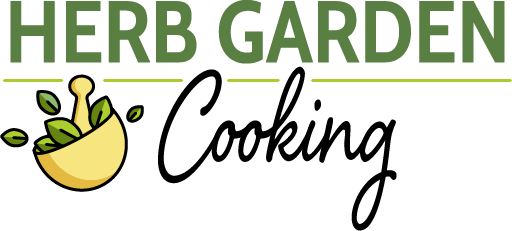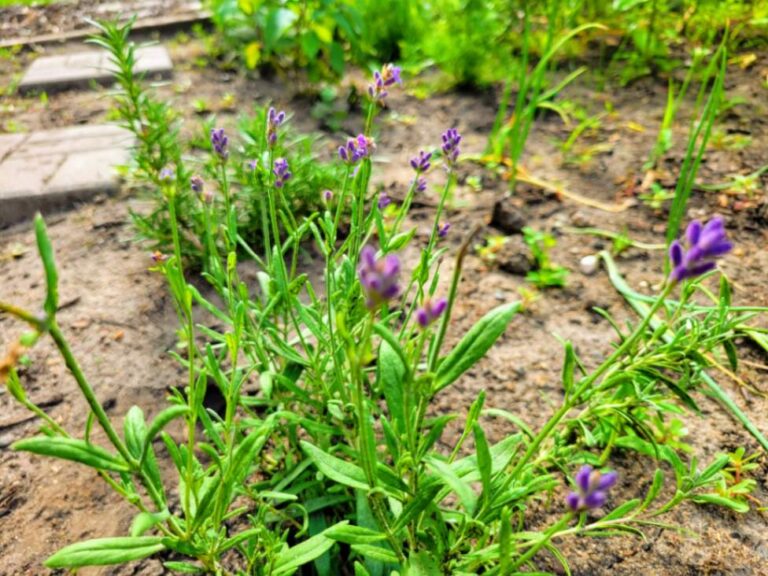This post may contain affiliate links which means I may receive a commission for purchases made through links. I only recommend products that I have personally used. As an Amazon Associate I earn from qualifying purchases. Learn more on my Private Policy page.

Strategically pairing lavender with compatible plants in your vegetable and herbs gardens can improve the overall health of your gardens. For centuries, gardeners have used the art of companion planting to maximize space, keep plants healthy, and deter pests naturally.
Lavender can serve as an excellent companion plant to many vegetables and herbs due to its pest-repellent qualities, keeping harmful insects at bay, and by promoting a healthier and more productive garden ecosystem.
What does lavender grow well with? Lavender is a great companion plant to herbs like rosemary, sage, thyme, and oregano as they have similar water needs and soil preferences. Broccoli, cabbage, and cauliflower are good companions because lavender repels pests that can harm these vegetables. Marigolds, catmint, and lavender repel insects well together.
Table of Contents
Best Herb Garden Companions to Lavender
When lavender companion planting, it is crucial to choose herbs that share similar growing requirements. Certain herbs also act as natural disease repellents and space-maximizers when planting them as lavender companion plants, fostering a thriving and efficient garden ecosystem.
Herbs with Similar Drought Tolerance and Growing Conditions
Lavender thrives in well-drained soil and requires minimal watering once established. Selecting herbs that can tolerate drought-like conditions is crucial when selecting lavender companion plants for your herb garden. Fortunately, there are several herbs that fit this requirement perfectly and make great companion plants for lavender.
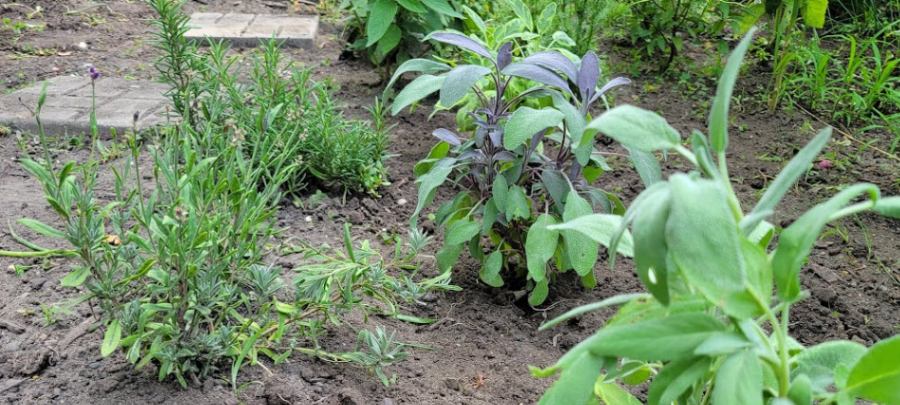

Rosemary: Lavender and rosemary both require similar amounts of sunlight, thrive in well-drained soil, and prefer drier conditions, making them ideal partners in the garden. Known for its fragrant leaves and delicate blue flowers, rosemary as a companion is an excellent choice to grow alongside lavender.

Sage: With comparable water requirements, sage is a good companion to lavender. With its soft gray-green foliage and vibrant purple flowers, sage complements lavender beautifully and similarly prefers full sun exposure. Moreover, sage’s antifungal properties can help protect lavender from diseases commonly affecting it.

Thyme: With its low watering needs, the growing requirements of thyme align perfectly with those of lavender, making thyme a good companion plant to lavender. Thyme and lavender are both quite drought-resistant, making them ideal garden partners.

Oregano: Lavender and oregano share preferences for well-draining soils and limited watering. They are both drought tolerant plants and share similar sun and soil requirements, making oregano a good companion plant to lavender.
These herbs are all well-suited for climates with relatively mild winters and warm summers, typically falling within USDA hardiness zones 5 to 9 (although rosemary is not quite as cold tolerant as the others). Their ability to thrive in similar conditions allows gardeners to create a cohesive herb garden while also simplifying care and maintenance efforts.
Antifungal Properties for Disease Prevention
Rosemary, sage, thyme, and oregano have antifungal properties, which can be a significant advantage when planting them alongside lavender. These herbs contain natural compounds in their essential oils that can help ward off diseases that commonly affect lavender plants.
Lavender with Broccoli, Cabbage & Cauliflower
Lavender emits a strong aroma that repels many insects known to feast on brassica crops such as broccoli, cabbage, and cauliflower. By intermingling these plants in your garden beds, you create a natural barrier against brassica pests without resorting to pesticides.
When planting brassicas and lavender together, it is important to consider the fact that they have different needs. Brassicas prefer cool temperatures and consistent moisture, while lavender thrives in warm, well-draining soil. Provide adequate sunlight, suitable soil, and water to each plant accordingly for successful companion planting. Growing lavender in a container near brassica crops is a common solution to satisfying their differing water needs and growing requirements.
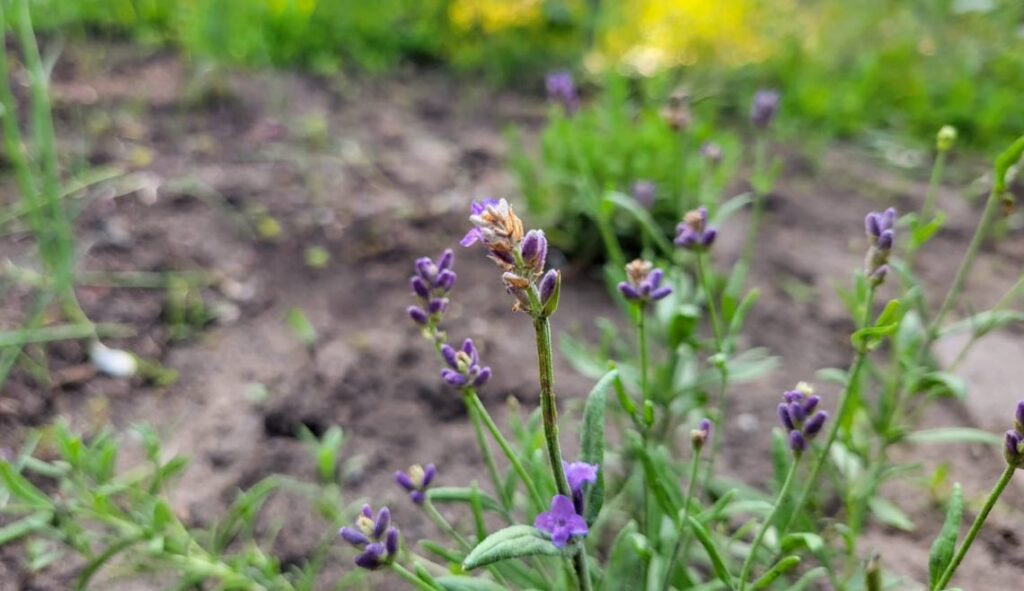
Lavender makes a good companion plant to these members of the brassica family:

Broccoli: With its ability to repel aphids and cabbage loopers with its strong fragrance, lavender is a good garden companion for broccoli. Lavender creates a more pest-resistant environment and promotes healthier growth for your broccoli plants.

Cabbage: Lavender is an excellent companion plant for cabbage as it acts as a natural deterrent to cabbage moths, which is a common pest for broccoli. The strong scent of lavender helps repel these pests, reducing the risk of infestations and protecting cabbage plants from damage.

Cauliflower: By fighting off common brassica family pests, lavender makes an ideal gardening partner to cauliflower as well, helping to ward off insects from feeding off of it.
The natural pest-repellent properties of lavender provide an added layer of defense against common brassica pests, reducing the need for chemical interventions.
Lavender, Marigolds and Catmint for Pest Control
You can create a pest-resistant trio in your garden by strategically combining lavender with marigolds and catmint.
Marigolds: Natural Pest-Repellent Allies with Lavender

When planted near lavender, marigolds act as a powerful deterrent against common garden pests such as aphids, whiteflies, and spider mites. These tiny insects can wreak havoc on your plants, sucking out vital nutrients and causing damage.
Marigolds also attract beneficial insects that help control pest populations naturally. Ladybugs and lacewings are attracted to marigold flowers. These helpful bugs feed on harmful pests like aphids and spider mites, keeping their numbers in check.
Catmint: Attract Beneficial Pollinators to Your Garden

Catmint (also known as catnip) is another excellent companion plant for pest control, as it emits a strong odor that repels many common garden pests such as ants, flea beetles, and aphids.
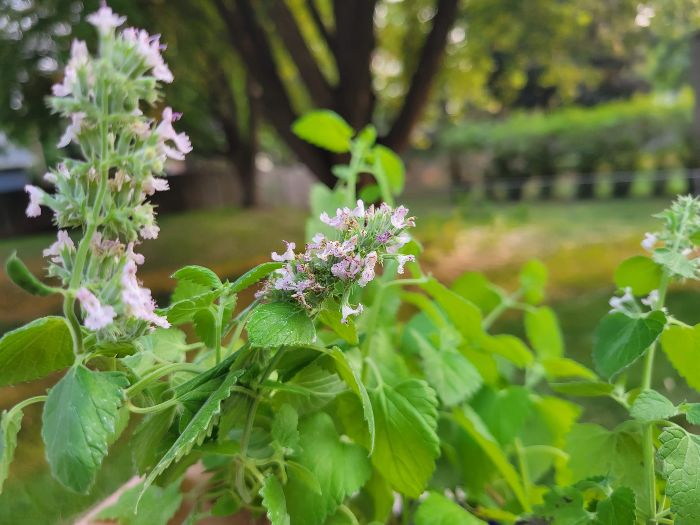
Catmint has the added benefit of attracting beneficial pollinators like bees and butterflies to your garden. These pollinators play a crucial role in plant reproduction, ensuring better fruit set and increased yields in neighboring fruits and vegetables.
A Pest-Fighting Trio: Lavender, Marigolds and Catmint
Lavender is itself a natural pest-repellent, containing natural compounds such as linalool and linalyl acetate, which act as a natural deterrent against insects such mosquitoes, flies, moths, and fleas.
Interplanting lavender, marigolds, and catmint together within your garden offers a powerful and natural approach to deter common garden pests. The combination of these three plants acts as natural repellents against a wide range of pests, effectively discouraging them from settling in the garden. By strategically placing these companions throughout your garden beds, the scents permeate the area, creating an environment that pests find unappealing, reducing the likelihood of pest infestations.
Common Flowering Companions to Lavender
Lavender is not only a great addition to culinary gardens, but it also serves as an excellent companion for various flowering plants

Roses and lavender form a stunning visual combination in any garden. Lavender’s scent deters aphids that attack roses. This harmonious duo also attracts beneficial insects like bees and butterflies, enhancing the garden’s overall appeal and ecosystem.
Yarrow pairs beautifully with lavender, adding visual diversity to your garden. Yarrow’s presence attracts beneficial insects like ladybugs and lacewings, which prey on harmful pests such as aphids and spider mites. This symbiotic relationship fosters a healthy ecosystem and enhances the garden’s beauty.

Zinnias are annual flowers which come in red, orange, pink, purple, and white. They attract bees and butterflies with their nectar-rich blooms. The presence of pollinators benefits both zinnias and lavender, encouraging cross-pollination and abundant flower production.
Lavender serves as an excellent companion for various flowering plants, enhancing the garden’s beauty and health. Its aromatic properties repel pests and attract beneficial insects, which helps to foster a harmonious and thriving ecosystem.
What Not to Plant Next to Lavender
Mint Does Not Go Well with Lavender

Mint thrives in consistently moist soil, while lavender prefers well-drained soil and thrives in drier conditions. This difference in growing conditions makes mint and lavender incompatible as garden companions. Mint also has invasive properties and tends to spread rapidly through underground rhizomes. Mint’s aggressive nature can overpower lavender plants, causing lavender to struggle.

To ensure the health and vigor of your lavender plants, it is best to avoid planting them alongside mint. However, if you still want to grow these two herbs together, consider using containers or raised beds where you can control their growth and provide separate growing conditions.
Plant Lavender Away from Moisture Loving Plants
Lavender thrives in dry conditions and should not be planted near moisture-loving plants. Hostas, impatiens, and ferns should not be planted with lavender, as they require consistent watering and prefer damp soil.
Planting these moisture-loving plants near your lavender can create an imbalance in water availability. Lavender performs best in well-drained soil with minimal watering needs. When surrounded by moisture-loving companions, the excess water they require could lead to root rot or other fungal diseases for the lavender plant.
To prevent this issue, it’s best to keep a distance between lavender and these moisture-loving plants.
Conclusion
Lavender companion planting offers gardeners the chance to harness nature’s own mechanisms for fostering plant health, maximizing space, and repelling pests.
To make the most out of your lavender companion planting, consider these key points:
- When planting lavender, choose companion herbs that have similar growing needs to help it grow better and create a more efficient garden ecosystem.
- Choose herbs like rosemary, sage, thyme, and oregano that can handle dry conditions like lavender.
- Plant lavender alongside brassica crops such as broccoli, cabbage, and cauliflower to create a natural barrier against pests. But be mindful of the fact that lavender has different growing requirements than brassicas.
- Use marigolds and catmint alongside lavender for natural pest control.
- Lavender is a good companion for flowers like roses, yarrow, and zinnias.
- Avoid planting lavender next to mint, as their growing conditions are incompatible and mint’s invasive nature can overpower lavender.
- Avoid planting lavender near moisture-loving plants like hostas, impatiens, and ferns, as these plants have very different growing conditions from lavender.
By following these guidelines, you can create a thriving herb garden with vibrant lavender plants at its center.
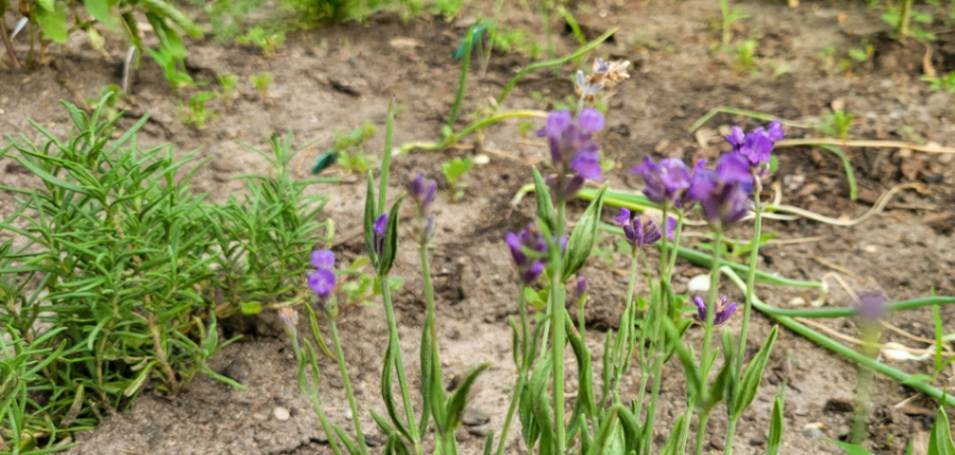
Frequently Asked Questions (FAQs)
Can I plant lavender next to vegetables?
Lavender is an excellent companion plant to vegetables like broccoli, cabbage and cauliflower due to lavender’s ability to repel pests that attack these vegetables. When planting together, be mindful of their distinct growing needs. Planting lavender in containers can address these differences in growing requirements.
What should not be planted next to lavender?
Lavender should not be planted near mint. Lavender prefers dry conditions while mint prefers consistent moisture. Mint can also invade and dominate lavender’s space. Lavender should also not be grown near plants with high watering needs such as hostas, impatiens, and ferns.
How often should I water lavender?
Lavender prefers well-drained soil and thrives in drier conditions. Watering established lavender once every two weeks is usually sufficient unless there are prolonged periods of drought.
Where it the best place for lavender in the garden?
It is best to plant lavender in a sunny spot in your garden that has well-draining soil, preferably near other drought-tolerant plants that require little water such rosemary, thyme, and sage.
Does lavender keep bugs away?
Lavender repels a number of different insects including mosquitoes, flies, moths, fleas, and certain types of beetles. Lavender has a strong fragrance that acts as a natural deterrent to these pests, making it a useful plant for insect repellent purposes.
Can I use lavender companion planting in containers or pots?
Lavender can be grown with suitable companion plants such as rosemary, thyme and oregano in containers. Lavender in pots can also be placed next to vegetables with different water needs like broccoli and cabbage to deter pests.
Will lavender come back every year?
Lavender is a perennial. Most varieties are hardy in USDA zones 5-9 and will bloom for 3-5 years if cared for properly. Lavender thrives with sun and dry soil. Lavender does not do well with overwatering, shade, or high humidity as it hails from the Mediterranean.
How long does it take for lavender to establish itself?
Lavender typically takes 1 to 3 years to fully establish itself after its planted, depending on factors like growing conditions and the variety of lavender. Proper care can expedite the process.
Happy gardening!
Last Updated on 25 September 2023 by Bob Lee
